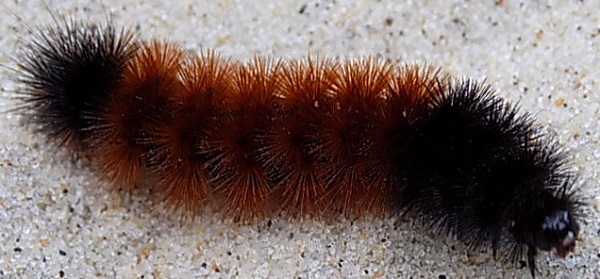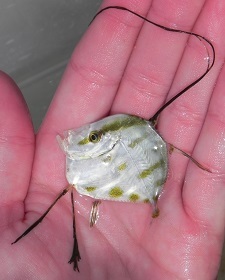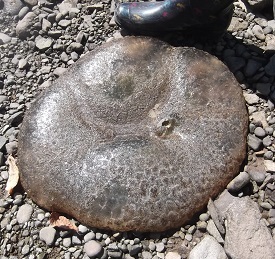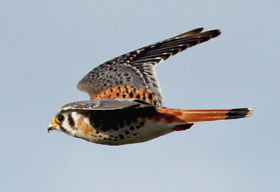Hudson River Almanac 10//1/17 - 10/7/17
The New York State Department of Environmental Conservation sent this bulletin on 10/13/2017 04:13 PM EDT |
| DEC Delivers - Information to keep you connected and informed from the NYS Department of Environmental Conservation |
| Share or view as a web page || Update preferences or unsubscribe |
|
|
With more than three weeks of little rain in the watershed, salinity in the estuary was rising. The presence of an uncommon marine fish (lookdown) in the Tappan Zee might signal the arrival of more tropical fishes. Monarchs continued to impress with their fall migration numbers. HIGHLIGHTS FROM LAST WEEK 9/28 – Alpine, HRM 18: During a late morning low tide, with the help of fifth-grade students from Main Street School in Irvington, the crew of the Hudson River sloop Clearwater set their otter trawl. Among the catch of fishes was a young-of-the-year lookdown. As we were checking the bag end of the trawl, a student asked me what the rarest fish I had ever caught was. I think that student willed that lookdown into our net!
9/29 – Alpine, HRM 18: Many of us watched from the State Line Lookout at what best could be described as a wild “bunker ball” below us in the Hudson River. Acres of Atlantic menhaden were massing in concentric groups trying to avoid unseen predators below the surface. Bluefish? Striped bass? Seals? There were surface-diving double-crested cormorants as well as aerial divers like osprey and bald eagles. As an osprey rose up with a huge bunker, an immature bald eagle checked out its fish but decided it would be too much trouble to pirate the catch. Soon, however, a huge motorboat flew down the river and broke up the party. NATURAL HISTORY NOTES 10/1 – Town of Saratoga, HRM 182: We discovered a newly-hatched snapping turtle 35 millimeters [mm] long on our driveway today. That seemed odd since there was no water closer than Sucker Brook, a half-mile away. We took it to a small pond, set it free, and watched as it promptly headed for the water. 10/1 – Schenectady, HRM 158: Six birders enjoyed a perfect fall day at the Woodlawn Preserve; the breeze was light and warblers abounded. The most productive spots were anywhere the sun touched young locusts, aspens, and birches. The birds foraged just above eye level. We were treated to ten warbler species including Nashville, Tennessee, yellow-rumped, black-throated green, black-throated blue, northern parula, palm, magnolia, blackpoll, and common yellowthroat. Due to beaver activity, the water level was very high. 10/1 – Albany County, HRM 136: Waterfowl numbers and diversity were beginning to build. At Basic Creek Reservoir in Westerlo this morning, I counted 66 ruddy ducks. Otherwise, there were green-winged teal, American wigeon, Canada geese, wood ducks, and a couple of hooded mergansers.
10/1 – Denning’s Point, HRM 60: There were swarms of Atlantic menhaden swirling close to shore around the southwest side of Denning’s Point on the flood tide early this morning. They had been here for the last two weeks, entertaining the migrating osprey that were having a picnic, getting a fish on every dive. 10/1 – Kowawese, HRM 59: Among anglers, it is called “last cast,” that moment when you need to pack it up and call it a day. It might be a dry fly, a bucktail jig, or a stink-bait for catfish. It is that decision to make a last cast to cap off a good day, or one not so good – it rarely does much to sway the results either way. Seiners have those moments as well. We hauled our net again and again this afternoon with the same result: just a single spottail shiner. “Last cast (haul) we announced.” Regardless of the outcome we were leaving. Like a wish come true, the net felt heavy on the way in for the first time and the bag was bulging with silver flashes. We had caught a serious school of young-of-the-year [YOY] blueback herring (50-59 mm) and striped bass (68-84 mm), as well as alewives (96-99 mm). The water had a comforting warmth of 74 degrees Fahrenheit and the salinity was 3.4 parts-per-thousand [ppt]. 10/1 – Orange County, HRM 55: I was at Black Rock Forest Consortium, adjacent to Storm King Mountain, talking about American eel research and the fact that traces of magnetite have been found in eels, possibly as part of an “internal compass” for finding directions. Operations manager Jack Caldwell handed me a dark, dense rock. “That’s magnetite! It is what gives Black Rock Forest its name.” [Magnetite is a mineral with magnetic properties found in igneous and metamorphic rocks, the very ones that comprise most of the Hudson Highlands. Geologist Allan Ludman dates the rocks at Storm King at about one billion years old, impressive but not close to the oldest rocks (more than 4.0 billion years old) that are found in northern Canada and Australia. Tom Lake.] 10/1 – Bedford, HRM 35: The raptor flight was surprisingly sparse at the Chestnut Ridge Hawkwatch today. Sharp-shinned hawks (10) were high count. Non-raptor observations included monarchs (14) and common loons (2). 10/1 – Croton Point, HRM 35: I stood on the beach at Mother’s Lap, reliving the just-concluded two days with students from Coman Hills School in Armonk. The students’ experiences went far beyond the usual seining of fish and telling their stories. We came upon a dead common carp (15 pounds) that was being visited by a bevy of black vultures. They had not left much for us to talk about except to explain this was nature’s way of using scavengers to clean up the messes. Also on the sand were foot-long Atlantic menhaden; each was missing its posterior end where a “smiley face” gave evidence of a bluefish bite.
[Batesian mimicry is a form of mimicry where a harmless species has evolved to imitate the warning signals of a harmful species directed at a predator of them both. It is named after the English naturalist Henry Walter Bates for his work on butterflies in the rainforests of Brazil. Tom Lake.] 10/2 – New Paltz, HRM 78: After several days of seeing none, we saw one ruby-throated hummingbird at the hummingbird sage flowers in our garden. There were still many good tubular flowers here for latecomers. It is easy to note the first time we see an arriving migrant in the spring, but not so easy to note or know when the last one was seen in the fall. 10/2 – Haverstraw Bay, HRM 36: From two eyewitness observers, Gareth Hougham learned of dolphins, at least one and maybe two, in the Hudson River just north of Croton Point. Many eyes began searching for them but the sighting has yet to be repeated. Kimberly Durham, Atlantic Marine Conservation Society, confirmed the story. This would not be at all unexpected; the lower estuary up through the Hudson Highlands (river mile 60) was presently teeming with Atlantic menhaden. That would be plenty enough motivation (see the humpback whale in the Upper Bay of New York Harbor last November in the midst of shoals of bunker). If you see a live and apparently healthy marine mammal or sea turtle in the Hudson River, please let the Atlantic Marine Conservation Society know. If you have photos or video, please send them to sightings@amseas.org. However, if you see a sick or injured marine mammal or sea turtle, please call the New York State Stranding Hotline (Riverhead Foundation for Marine Research & Preservation) immediately (631) 369-9829. 10/2 – Bedford, HRM 35: We had season high counts for both Cooper's hawks (16) and turkey vultures (22) at the Chestnut Ridge Hawkwatch today. Many birds were passing far south of us, visually distorted by heat haze. Non-raptor observations included monarch butterflies (15). 10/2 – Manhattan, HRM 1: We checked our research collection gear during an early afternoon high tide in Hudson River Park at The River Project's sampling station on the lighthouse tender Lilac and found two blue crabs (17.5 and 140 mm carapace width) in the crab pots. 10/3 – Greene County, HRM 112: After seeing very few monarchs this year in West Kill, three were simultaneously visiting some wild asters in the yard today, probably on a break from their migration. They were on the small side, but in perfect condition. Twenty years ago, at this time of year, we used to see flocks of monarchs flying high overhead. 10/3 – Stanfordville, HRM 84: I spotted a greater white-fronted goose on Ryder Pond this afternoon. The goose had all its attributes: brownish-gray body, white front, pink-orange bill, orange feet, and was associating with Canada geese. [The greater white-fronted goose (Anser albifrons), an Arctic breeder, appears once or twice most years during the fall or winter. They are usually found in large flocks of Canada geese, a reward for the patient birder who checks them carefully. Barbara Butler.]
10/4 – Hyde Park, HRM 82: A black bear was walking southbound along Howard Boulevard early this morning. After we had a brief conversation, the bear sauntered through our neighbor’s yard and down into an adjacent wetland. Bear sightings in our neighborhood seem to be elevated this year and trash cans and bird feeders have been pulled inside. 10/4 – Kowawese, HRM 59: As last light fell away from Breakneck Ridge we set about laying out our seine in the quiet and glassy shallows. This was an extra low “moon tide” and the full moon, a creamy-white globe, was up over the Fishkill Mountains to the east. With less than a half-inch of rain in 26 days, the salinity was pushing above 4.0 ppt. The tranquil water belied the rush of the many tiny YOY fishes that we soon captured, measured, and released. They included striped bass (65-67 mm), blueback herring (53-56 mm), and a few yearling alewives (90 mm). The water was a relaxingly warm 72 degrees F. 10/4 – Bedford, HRM 35: We had a very slow raptor flight today at the Chestnut Ridge Hawkwatch. Turkey vultures were overall high count (9) with sharp-shinned hawks (5) high count among raptors. Non-raptor observations included our high count for the season of monarchs (78). 10/4 – Piermont, HRM 25: Cresskill High School students helped us sample the Piermont Pier area this morning, ending with a quick haul of our seine. They netted Atlantic silversides (8), YOY striped bass (3), moon jellyfish (3), and male blue crabs ranging in size from a dime to a quarter. The salinity was a brackish 11.0 ppt and the river was 69 degrees F. 10/5 – Town of Poughkeepsie: The pair of bald eagles in nest NY62 seemed ready to begin their winter nest renovation. They have stayed in the general vicinity of the nest all summer, often stopping by to sit in the nest. The “new” dad (he replaced the original dad, N42, when that male was struck by a train last February) seemed particularly eager. This spring, the original NY62 female will begin her 18th breeding season. 10/5 – Saratoga County, HRM 157: On a perfect fall day, the Thursday birders visited the Vischer Ferry Preserve to see if the migration change-of-the-guard had begun. Sparrows were starting to move in; we had many song and white-throated with smaller numbers of savannah, white-crowned, and swamp sparrows. We picked up the full woodpecker “six-pack” with lively families of downy woodpeckers and yellow-bellied sapsuckers. The big surprise of the day came while playing eastern screech owl calls in an attempt to bring in small birds - two screech owls called back to us! 10/5 – Bedford, HRM 35: No surprises in another slow day at the Chestnut Ridge Hawkwatch. An immature northern harrier, as well as kestrels (3) and a merlin livened up the watch. Osprey were high count (6). Non-raptor observations included monarchs (29) that were back to their normal levels. 10/5 – Yonkers, HRM 18: While exploring with my co-worker Jason Muller on a very low tide to find a good spot for a Riverdale teacher’s Oyster Research Station, we were very excited to find that we had an entire “colony” of wild oysters –an estimated 100 though we were not able to do a full count – living along with a lot of barnacles and ribbed mussels on the bulkhead next to our beach The largest I saw was 80 mm valve length. I’m hoping to start a wild oyster survey to monitor their growth or population change. 10/5 – Manhattan, HRM 13.5: Inwood Hill Park seemed to be on the cusp of a season change. Along the inlet of Spuyten Duyvil Creek, the groundsel-bush (Baccharis halimifolia) was in full bloom and the smaller flowers of marsh elder (Iva frutescens) were beginning to open. Seaside goldenrod was still blooming and I saw one evening primrose. The path up through The Clove was strangely lacking in foliage probably due to a lack of rainfall; up on the ridge the plants looked drought-stressed. Some patches of poison ivy and a few Virginia creeper were red or chestnut-brown, but many leaves were withered while still green. Even sumac had very little color. Canada goldenrod was blooming nicely but the bluestem goldenrod flowers, though plentiful, seemed only half open. 10/6 – Town of Poughkeepsie, HRM 68: We found three banded woolly bear caterpillars, the larval form of the Isabella tiger moth (Pyrrharctia isabella), crawling on the playground pilings of Bowdoin Park, and gave a thought to the folkloric belief that the wider the caterpillar’s rusty brown sections, the milder the coming winter will be. Conversely, the wider the black sections are, the more severe the winter. Our three woolly bears were dominated by their brown sections flanked fore and aft by lesser black sections. If we were inclined to believe, we would expect a mild winter. [See banner photo of woolly bear caterpillar courtesy of Tom Lake.] 10/6 – Little Stony Point, HRM 55: Sunset arrived, dropping behind Butter Hill in the notch between Storm King and Crow’s Nest, more than a half hour before the rest of the valley. The air and the water were matched at 72 degrees F; the river was calm as glass and as comforting as a warm blanket. We hauled our seine in the twilight and found a school of YOY striped bass (60-110 mm) as well as some large spottail shiners (115-122 mm). When darkness covered the beach we expected a change in our catch and, perhaps only coincidently, we seined into a school of Atlantic silversides (88-92 mm), our first brackish-saltwater species of the season. The salinity was 4.0 ppt. 10/6 – Manhattan, HRM 1: Before removing them, we checked the research collection traps in Hudson River Park at The River Project's sampling station on the lighthouse tender Lilac. While we caught no fish, we did find several juvenile spider crabs. 10/6 – Bedford, HRM 35: Numbers of migrants were up slightly at the Chestnut Ridge Hawkwatch today. Sharp-shined hawks (13) were high count among raptors. Turkey vultures flying in the right direction (west/southwest) were judged to be migrants. Non-raptor observations included monarchs (69) as well as blue jays (29). 10/7 – Bedford, HRM 35: This was the best day so far for peregrine falcons (6) at the Chestnut Ridge Hawkwatch with five in the last three hours. Non-raptor observations included monarchs (58) still moving through in good numbers. 10/7 – Brooklyn: Halley McClanahan found a cunner in one of the Brooklyn Bridge Park Conservancy’s oyster traps in the East River. What made it a puzzling find was the black spot with a white ocellus on its rear dorsal fin. The literature, while describing how variable cunner coloration can be as adaptations to their environment, it made of no mention of such a spot. However, Bob Schmidt, searching for “juvenile cunner” found at least four photos of cunners taken by divers that showed fish with a spot and ocellus in the soft dorsal fin. [Cunners (Tautogolabrus adspersus) are a member of the wrasse family, Labridae, closely related to the tautog or blackfish. They are commonly found in the lower estuary in many habitats but preferring rocky areas where they feed on small shellfish and mollusks. Anglers know them, colloquially, as “bergalls,” and in New England they are called “chogies.” 10/7 – Kowawese, HRM 59: A strong south wind was blowing a gale out of the North Gate to the Hudson Highlands, causing chest-high rollers to crash on us as we seined. The power of each wave threatened to tip us over. Two sunsets could not have been any different as we thought of the glassy-calm river of last night at Little Stony Point. The “swash” or littoral zone of the beach (where the river meets the sand) was a tumult of energy. As we have seen before, the tumbling shallows were filled with white perch taking advantage of small invertebrates swept up in the turbid water. We also caught many YOY striped bass (54-87 mm), likewise at home in the turbulent water. The wild river was 72 degrees F and the salinity was 5.0 ppt. 10/7 – Dobbs Ferry, HRM 23: For the last two days there has been a “meteor shower” of monarch butterflies fluttering and drifting over our property. They have been stopping at the scant remains of buddleia blooms [butterfly bush] and the wasp-popular mature English ivy flowers. FALL 2017 NATURAL HISTORY PROGRAMS Saturday, October 14 – 1:00 PM HUDSON RIVER MILES The Hudson is measured north from Hudson River Mile 0 at the Battery at the southern tip of Manhattan. The George Washington Bridge is at HRM 12, the Tappan Zee 28, Bear Mountain 47, Beacon-Newburgh 62, Mid-Hudson 75, Kingston-Rhinecliff 95, Rip Van Winkle 114, and the Federal Dam at Troy, the head of tidewater, at 153. The tidal section of the Hudson constitutes a bit less than half the total distance – 315 miles – from Lake Tear of the Clouds to the Battery. Entries from points east and west in the watershed reference the corresponding river mile on the mainstem. TO CONTRIBUTE YOUR OBSERVATIONS OR TO SUBSCRIBE The Hudson River Almanac is compiled and edited by Tom Lake and emailed weekly by DEC's Hudson River Estuary Program. Share your observations by e-mailing them to trlake7@aol.com. To subscribe to the Almanac (or to unsubscribe), use the links on DEC's Hudson River Almanac or DEC Delivers web pages. Discover New York State Conservationist - the award-winning, advertisement-free magazine focusing on New York State's great outdoors and natural resources. Conservationist features stunning photography, informative articles and around-the-state coverage. Visit the Conservationist webpage for more information. USEFUL LINKS National Oceanic and Atmospheric Administration online tide and tidal current predictions are invaluable when planning Hudson River field trips. For real-time information on Hudson River tides, weather and water conditions from twelve monitoring stations, visit the Hudson River Environmental Conditions Observing System website. Information about the Hudson River Estuary Program is available on DEC's website at http://www.dec.ny.gov/lands/4920.html . Smartphone app available for New York outdoor enthusiasts! Copies of past issues of the Hudson River Almanac, Volumes II-VIII, are available for purchase from the publisher, Purple Mountain Press, (800) 325-2665, or email purple@catskill.net. |


 [Lookdowns (Selene vomer), are a tropical-looking temperate marine stray in the Hudson River. They are one of six jacks (Carangidae) documented for the Hudson. Their center of abundance is far down the Atlantic Coast south of the Carolinas. Lookdowns are carried north as eggs and larvae by the Gulf Stream until they become juveniles when they branch off entering Mid-Atlantic coast estuaries. Tom Lake. Image of young lookdown from Virginia State Parks Flickr site under terms of
[Lookdowns (Selene vomer), are a tropical-looking temperate marine stray in the Hudson River. They are one of six jacks (Carangidae) documented for the Hudson. Their center of abundance is far down the Atlantic Coast south of the Carolinas. Lookdowns are carried north as eggs and larvae by the Gulf Stream until they become juveniles when they branch off entering Mid-Atlantic coast estuaries. Tom Lake. Image of young lookdown from Virginia State Parks Flickr site under terms of  10/1 – Delaware County, HRM 106: Several of the volunteers for the Pepacton Reservoir Cleanup Day told me of finding strange, gelatinous “blobs” on the shore of this New York City reservoir. I e-mailed the Water Quality group this morning and found out that they are a giant freshwater bryozoan (Pectinatella magnifica) that graze on algae and are an indicator of clean water. These colonial organisms are made up of many individual colonies and their origin dates to more than 500 million years ago. Scientists have difficulty making up their minds as to which animal phyla they belong. [Photo courtesy of Beth Waterman.]
10/1 – Delaware County, HRM 106: Several of the volunteers for the Pepacton Reservoir Cleanup Day told me of finding strange, gelatinous “blobs” on the shore of this New York City reservoir. I e-mailed the Water Quality group this morning and found out that they are a giant freshwater bryozoan (Pectinatella magnifica) that graze on algae and are an indicator of clean water. These colonial organisms are made up of many individual colonies and their origin dates to more than 500 million years ago. Scientists have difficulty making up their minds as to which animal phyla they belong. [Photo courtesy of Beth Waterman.] 10/2 – Millbrook, HRM 82: I was treated to an unexpected example of Batesian mimicry this afternoon when I reached to rescue a small milk snake from my dog. To my surprise, the milk snake coiled, shook its tail like a rattler, drew back its head and struck at my hand. I stared long and hard at the spots on its back before I persuaded myself that it really was a milk snake. According to the University of Virginia Mountain Lake Biological Station, milk snakes shake their tails in leaf litter and otherwise mimic copperheads in an attempt to scare away predators. [Photo of young milk snake courtesy of Tracy Ducasse under terms of
10/2 – Millbrook, HRM 82: I was treated to an unexpected example of Batesian mimicry this afternoon when I reached to rescue a small milk snake from my dog. To my surprise, the milk snake coiled, shook its tail like a rattler, drew back its head and struck at my hand. I stared long and hard at the spots on its back before I persuaded myself that it really was a milk snake. According to the University of Virginia Mountain Lake Biological Station, milk snakes shake their tails in leaf litter and otherwise mimic copperheads in an attempt to scare away predators. [Photo of young milk snake courtesy of Tracy Ducasse under terms of  10/3 – Bedford, HRM 35: Sharp-shinned hawks (20) were high count today at the Chestnut Ridge Hawkwatch with a nice showing of American kestrels (11). Non-raptor observations included monarchs (33), still on the wing despite a cold wind. [Photo of American kestrel by Robert Burton courtesy of U.S. Fish and Wildlife Service.]
10/3 – Bedford, HRM 35: Sharp-shinned hawks (20) were high count today at the Chestnut Ridge Hawkwatch with a nice showing of American kestrels (11). Non-raptor observations included monarchs (33), still on the wing despite a cold wind. [Photo of American kestrel by Robert Burton courtesy of U.S. Fish and Wildlife Service.]